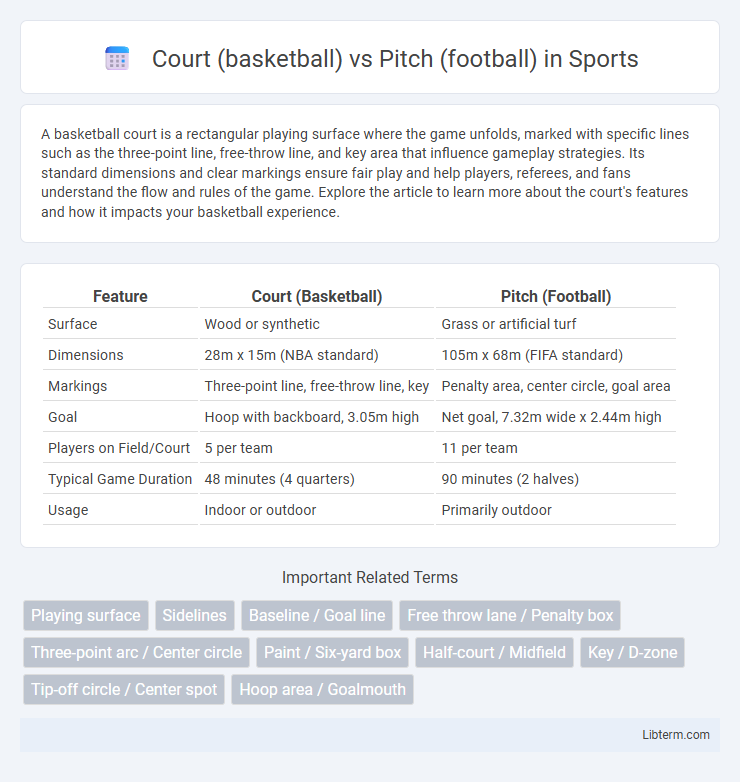A basketball court is a rectangular playing surface where the game unfolds, marked with specific lines such as the three-point line, free-throw line, and key area that influence gameplay strategies. Its standard dimensions and clear markings ensure fair play and help players, referees, and fans understand the flow and rules of the game. Explore the article to learn more about the court's features and how it impacts your basketball experience.
Table of Comparison
| Feature | Court (Basketball) | Pitch (Football) |
|---|---|---|
| Surface | Wood or synthetic | Grass or artificial turf |
| Dimensions | 28m x 15m (NBA standard) | 105m x 68m (FIFA standard) |
| Markings | Three-point line, free-throw line, key | Penalty area, center circle, goal area |
| Goal | Hoop with backboard, 3.05m high | Net goal, 7.32m wide x 2.44m high |
| Players on Field/Court | 5 per team | 11 per team |
| Typical Game Duration | 48 minutes (4 quarters) | 90 minutes (2 halves) |
| Usage | Indoor or outdoor | Primarily outdoor |
Introduction to Sports Venues: Court vs Pitch
A basketball court is a rectangular playing surface typically measuring 28 by 15 meters, designed to accommodate fast-paced, indoor gameplay with marked lines such as the three-point arc and free-throw lane. In contrast, a football pitch, also known as a soccer field, is a larger rectangular grass or artificial turf surface ranging from 100 to 110 meters in length and 64 to 75 meters in width, with goal areas and penalty boxes defining crucial zones. These sports venues reflect the unique spatial requirements and dynamics of basketball and football, influencing game strategy and player movement.
Defining Court in Basketball
A basketball court is a rectangular playing surface measuring 94 by 50 feet, designed specifically for the fast-paced, high-intensity game of basketball. The court features distinct markings including the three-point line, free-throw lane, and center circle, which regulate shots and gameplay dynamics. Unlike a football pitch, the basketball court's hard, wooden floor surface enhances player agility and ensures consistent ball bounce essential for dribbling and shooting accuracy.
Understanding the Pitch in Football
A football pitch typically measures 100 to 110 meters in length and 64 to 75 meters in width, providing a large rectangular playing surface that influences game strategies and player positioning. The pitch includes key markings such as the penalty area, center circle, and goal lines, which define the zones for specific gameplay rules like offsides and fouls. Understanding the pitch's dimensions and markings enhances tactical awareness, enabling players to optimize space utilization and effectively coordinate team movements during a match.
Dimensions and Markings Compared
A basketball court typically measures 28 by 15 meters with distinct markings for the three-point line, free-throw line, and key area essential for gameplay. In contrast, a football pitch ranges from 90 to 120 meters in length and 45 to 90 meters in width, featuring markings such as the halfway line, penalty area, and corner arcs critical for regulation matches. The court's smaller, rectangular surface supports rapid, continuous play, while the football pitch's larger expanse facilitates strategic positioning and diverse play styles.
Surface Materials and Construction
Basketball courts typically feature hardwood surfaces made from maple, offering a smooth, durable finish that enhances ball bounce and player traction. Football pitches usually consist of natural grass or synthetic turf designed to withstand outdoor weather conditions and provide cushioning to minimize player injuries. The construction of basketball courts involves precise layering for shock absorption, while football pitches require robust drainage systems and soil stabilization to maintain playability.
Equipment and Accessories on Each Venue
Basketball courts feature a smooth hardwood surface marked with a three-point line, free-throw line, and key area, accompanied by a hoop with a net and backboard as essential equipment. Football pitches consist of natural or artificial grass fields with goalposts at each end, sidelines, and markings for yard lines and penalty areas. Accessories for basketball courts include shot clocks and scorer's tables, whereas football pitches utilize corner flags, goal nets, and team benches.
Player Movement and Space Utilization
In basketball, player movement revolves around constant cutting, screening, and quick changes of direction to exploit tight, confined spaces on the court for optimal shooting and passing opportunities. Football pitches require broader spatial awareness with players utilizing long sprints, strategic positioning, and expansive lateral movement to control zones and create passing lanes over a larger field. Both sports emphasize dynamic space utilization, yet basketball demands rapid transitions in smaller areas, while football prioritizes endurance and spatial coverage across an expansive pitch.
Impact on Game Tactics and Strategies
Court dimensions and surface directly influence basketball tactics, emphasizing quick cuts, fast transitions, and precise spacing to exploit limited area and promote aggressive defense. Football pitches, being larger and variable in conditions, encourage strategic formations, long passes, and endurance-based play, allowing for diverse tactical approaches such as counter-attacks and pressing systems. The spatial constraints of a basketball court demand continuous player movement and rapid decision-making, while a football pitch facilitates broader spatial control and positional discipline.
Audience Experience and Venue Atmosphere
Basketball courts, being smaller and enclosed, offer fans an intense, immersive atmosphere with close proximity to players, heightening auditory and visual engagement. Football pitches, larger and often open-air, provide expansive views accommodating massive crowds, creating a dynamic environment energized by collective chants and stadium-wide coordination. Both venues maximize audience experience by tailoring acoustics and sightlines to the sport's unique pace and spatial requirements.
Conclusion: Key Differences and Similarities
Basketball courts typically measure 28 by 15 meters with a smooth hardwood surface, while football pitches vary between 90 and 120 meters in length and feature natural or artificial grass. Both serve as standardized playing areas crucial for their sports, governed by specific dimensions and markings that define gameplay zones and scoring areas. Their differences reflect the distinct physical demands and rules of basketball and football, but both optimize player movement, safety, and game fluidity.
Court (basketball) Infographic

 libterm.com
libterm.com